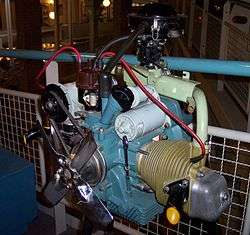DAF Daffodil
The DAF Daffodil is a small family car that was manufactured by DAF from 1961 until 1967.[1] It replaced the DAF 600. At the same time DAF launched the DAF 750 which was essentially the same car but with less luxurious fittings and less chrome trim on the outside. The Daffodil was conceived as an export version of the 750, market response dictated that the 750 ceased production in 1963 while the Daffodil, benefitting from a succession of mild face lifts, remained in production until 1967. The Daffodil was replaced by the very similar but slightly more powerful DAF 33.
| DAF 750 / DAF Daffodil | |
|---|---|
_frontright.jpg) | |
| Overview | |
| Manufacturer | DAF |
| Also called | DAF 30 / 31 / 32 |
| Production | 1961–1963 (750) 16,767 produced 1961–1967 (Daffodil) 132,919 produced |
| Assembly | Eindhoven, Netherlands |
| Designer | Johan van der Brugghen |
| Body and chassis | |
| Class | Small family car |
| Body style | Saloon Panel van with or without side windows |
| Layout | FR layout |
| Powertrain | |
| Engine | 746 cc Flat twin |
| Transmission | Variomatic |
| Dimensions | |
| Wheelbase | 2,050 mm (80.7 in) |
| Length | 3,610 mm (142.1 in) |
| Height | 1,440 mm (56.7 in) |
| Chronology | |
| Predecessor | DAF 600 |
| Successor | DAF 33 |

The names
The Daffodil name worked well in some markets, but in Germany the more luxuriously equipped version of the DAF 750 was known as the DAF 30. Upgrades in 1963 and 1965 were marked by name changes to DAF 31 and DAF 32. In these markets the launch of the DAF 33 in 1967 was merely a continuation of an existing line.
The engine
The 746 cc four stroke air cooled 2 cylinder Boxer engine had the same stroke as in the 600, but the bore was increased from 76 mm to 85.5 mm. Claimed power output was also increased from 22 bhp (16 kW) to 30 bhp (22 kW), and a maximum speed of 105 km/h (65 mph) was claimed. The 0-50 mph (80 km/h) time was 29 seconds, as tested by the Consumers Union in the United States.
Running gear
The DAF 600 was the first car to have a continuously variable transmission (CVT) system - the innovative DAF Variomatic.,[2] the same system was carried over to the 750 and its variants. The DAF Variomatic employs centrifugal weights to control the drive ratio of the transmission and is enhanced by the engine manifold vacuum. The action of the bob weights and inlet vacuum combined to pull together the cheeks of two, variable diameter, driving pulleys, driven directly from the engine. These were connected, by rubber 'V' belts, to two similar driven pulleys, connected to the drive wheels. The cheeks of the driven pulleys were held together by spring tension, which was progressively overcome as the drive pulleys expanded and the tension of the belts increased. The DAF Variomatics were thereby the only cars ever produced which went faster by the simple expedient of gently and gradually releasing the accelerator once top engine speed had been reached, as the increased vacuum took over from the reducing bob weight speed. The Variomatic also permitted increased engine braking by operating a switch on the dashboard which reversed the action of the vacuum on the pulley's diaphragm, seeking a lower ratio with increased manifold vacuum. Two separate transmissions ran the two driving wheels, eliminating the need for a differential since belt slippage allowed for the different speeds of the inner and outer wheels. The duplication also provided redundancy, if one belt broke the vehicle could still be driven. An incidental feature was that in reverse, at least for earlier examples, the same top speed could be achieved as forwards. Later cars locked the transmission in the lowest ratio when reverse was selected.
Chronology
Between 1961 and 1967 the mechanical aspects of the car were not significantly changed.
1963 marked the withdrawal of the 750 and 30 badges, and the DAF 30 was replaced by the DAF 31. The exterior of the car was modestly reworked with input from Giovanni Michelotti which involved sharpened angles and more prominent fins: the interior was also significantly upgraded.
In 1965 the DAF 32 replaced the DAF 31. This upgrade was marked by further limited changes to the body panels, again involving Michelotti whose influence would continue to be seen on DAF passenger cars until the Limburg car assembly business was acquired by Volvo.[3]
Popular references
The DAF Daffodil appeared in the 1960s spy drama series The Baron, driven by Cordelia (Sue Lloyd). It also gave its name to the late 1980s/early 1990s Manchester Indie band The New Fast Automatic Daffodils, after an advert for the car, which stated "The New, Fast Daffodil - fully Automatic".
Notes
- Michael Sedgwick and Mark Gillies (1986). A-Z of CARS 1945-1970. Temple Press. ISBN 0-600-33391-4.
- Hilton Holloway, Martin Buckley (2002). 20th Century Cars. Carlton. ISBN 1-84222-835-8.
- http://www.vdlnedcar.nl/?page/4842402/Profile.aspx
External links
![]()
- This article incorporates text translated from the Dutch Wikipedia articles on the DAF Daffodil and the DAF 750 as of 2008-03-10 .